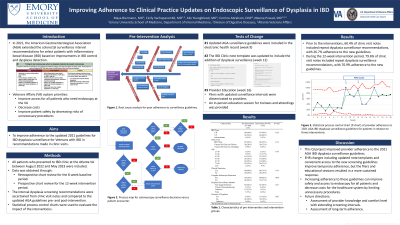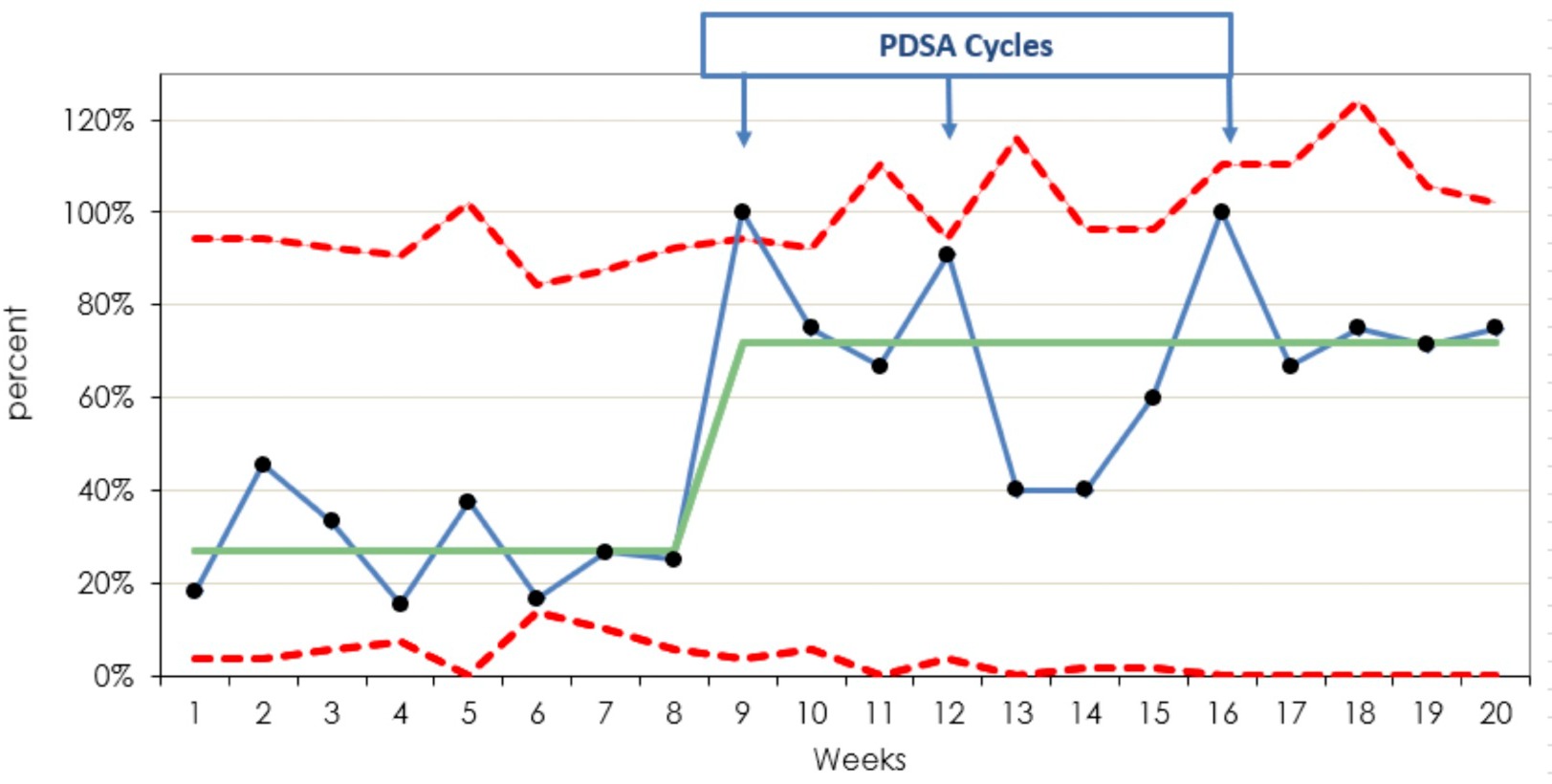Monday Poster Session
Category: IBD
P2213 - Improving Adherence to Clinical Practice Updates on Endoscopic Surveillance of Dysplasia in IBD
Monday, October 23, 2023
10:30 AM - 4:15 PM PT
Location: Exhibit Hall

Has Audio

Maya Biermann, MD
Emory University School of Medicine
Atlanta, GA
Presenting Author(s)
Maya Biermann, MD1, Cicily Vachaparambil, MD2, Alix Youngblood, MD1, Corrine Abraham, DNP, RN3, Meena A.. Prasad, MD4
1Emory University School of Medicine, Atlanta, GA; 2Emory University, Atlanta, GA; 3Atlanta VA Health Care System, Marietta, GA; 4Atlanta VA Medical Center, Emory University, Decatur, GA
Introduction: In 2021, the American Gastroenterological Association (AGA) extended the colorectal surveillance interval recommendation for select patients with inflammatory bowel disease (IBD) based on improvements in IBD control and dysplasia detection. Our quality improvement project aims to improve adherence to these new guidelines in recommendations made in follow-up clinic visits.
Methods: All patients who presented to IBD clinic at the local Veterans Affairs Hospital between August 2022 and May 2023 were included. Data was obtained through retrospective chart review for the 8 week baseline period, and prospective chart review for the 12 week intervention period. Three interventions were implemented: 1) updated AGA surveillance guidelines were included in the electronic health record (EHR) (week 9); 2) the IBD clinic note template was updated to include the addition of dysplasia surveillance (week 12); and 3) fliers with updated surveillance intervals were disseminated to providers, and an in-person educational session was provided (week 16). The interval dysplasia screening recommendations were ascertained from clinic visit notes and compared to the updated AGA guidelines pre- and post-intervention. Statistical process control charts were used to evaluate the impact of the interventions.
Results: Of the 306 patients reviewed, 110 were excluded for duration of disease not meeting surveillance criteria, history of prior colectomy, and lack of follow up (Table 1). Prior to the interventions, an average of 60.4% of clinic visits included repeat dysplasia surveillance recommendations, with 26.7% adherence to the new guidelines. During the 12 week intervention period, an average of 79.6% of clinic visits included repeat dysplasia surveillance recommendations, with 70.9% adherence to the new guidelines (Figure 1).
Discussion: This project improved provider adherence to the 2021 AGA dysplasia surveillance guidelines for patients with IBD. EHR changes including updated note templates and convenient access to the new screening guidelines improved temporary adherence, but the fliers and educational session resulted in a more sustained response. Increasing adherence to such guidelines can improve safety and access to endoscopy for all patients, and decrease costs for the healthcare system by limiting unnecessary procedures. Future directions should include assessment of provider knowledge and comfort level with extending screening intervals to improve long-term adherence.

Disclosures:
Maya Biermann, MD1, Cicily Vachaparambil, MD2, Alix Youngblood, MD1, Corrine Abraham, DNP, RN3, Meena A.. Prasad, MD4. P2213 - Improving Adherence to Clinical Practice Updates on Endoscopic Surveillance of Dysplasia in IBD, ACG 2023 Annual Scientific Meeting Abstracts. Vancouver, BC, Canada: American College of Gastroenterology.
1Emory University School of Medicine, Atlanta, GA; 2Emory University, Atlanta, GA; 3Atlanta VA Health Care System, Marietta, GA; 4Atlanta VA Medical Center, Emory University, Decatur, GA
Introduction: In 2021, the American Gastroenterological Association (AGA) extended the colorectal surveillance interval recommendation for select patients with inflammatory bowel disease (IBD) based on improvements in IBD control and dysplasia detection. Our quality improvement project aims to improve adherence to these new guidelines in recommendations made in follow-up clinic visits.
Methods: All patients who presented to IBD clinic at the local Veterans Affairs Hospital between August 2022 and May 2023 were included. Data was obtained through retrospective chart review for the 8 week baseline period, and prospective chart review for the 12 week intervention period. Three interventions were implemented: 1) updated AGA surveillance guidelines were included in the electronic health record (EHR) (week 9); 2) the IBD clinic note template was updated to include the addition of dysplasia surveillance (week 12); and 3) fliers with updated surveillance intervals were disseminated to providers, and an in-person educational session was provided (week 16). The interval dysplasia screening recommendations were ascertained from clinic visit notes and compared to the updated AGA guidelines pre- and post-intervention. Statistical process control charts were used to evaluate the impact of the interventions.
Results: Of the 306 patients reviewed, 110 were excluded for duration of disease not meeting surveillance criteria, history of prior colectomy, and lack of follow up (Table 1). Prior to the interventions, an average of 60.4% of clinic visits included repeat dysplasia surveillance recommendations, with 26.7% adherence to the new guidelines. During the 12 week intervention period, an average of 79.6% of clinic visits included repeat dysplasia surveillance recommendations, with 70.9% adherence to the new guidelines (Figure 1).
Discussion: This project improved provider adherence to the 2021 AGA dysplasia surveillance guidelines for patients with IBD. EHR changes including updated note templates and convenient access to the new screening guidelines improved temporary adherence, but the fliers and educational session resulted in a more sustained response. Increasing adherence to such guidelines can improve safety and access to endoscopy for all patients, and decrease costs for the healthcare system by limiting unnecessary procedures. Future directions should include assessment of provider knowledge and comfort level with extending screening intervals to improve long-term adherence.

Figure: Statistical process control chart of provider adherence to 2021 AGA dysplasia surveillance guidelines for patients in IBD in relation to three interventions.
Disclosures:
Maya Biermann indicated no relevant financial relationships.
Cicily Vachaparambil indicated no relevant financial relationships.
Alix Youngblood indicated no relevant financial relationships.
Corrine Abraham indicated no relevant financial relationships.
Meena Prasad indicated no relevant financial relationships.
Maya Biermann, MD1, Cicily Vachaparambil, MD2, Alix Youngblood, MD1, Corrine Abraham, DNP, RN3, Meena A.. Prasad, MD4. P2213 - Improving Adherence to Clinical Practice Updates on Endoscopic Surveillance of Dysplasia in IBD, ACG 2023 Annual Scientific Meeting Abstracts. Vancouver, BC, Canada: American College of Gastroenterology.
